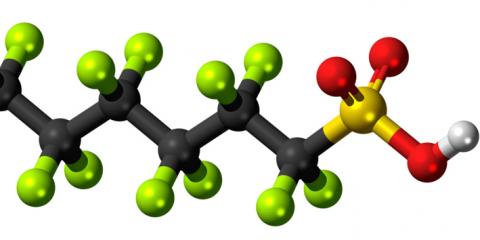Reactions: Study warns of PFAS contamination in global water systems
A "large fraction" of groundwater samples are contaminated by perfluoroalkyl and polyfluoroalkyl substances (PFASs) and would be considered unacceptable for drinking water, a study claims. The analysis, published by Nature Geoscience, brings together data from 273 studies of surface and groundwater samples from around the world since 2004. The exact proportion of samples exceeding the thresholds varies according to the standards considered. For example, 69% of groundwater samples with no known source of contamination exceed the Canadian threshold, but the figure is only 6% if the EU criterion for the sum of all PFASs is considered.

Irene Navarro - PFAS agua EN
Irene Navarro
Researcher at CIEMAT's Persistent Organic Pollutants and Emerging Contaminants in the Environment Unit
In this research, an extensive and worldwide dataset from 273 environmental studies was evaluated to provide per- and polyfluoroalkyl substances (PFAS) occurrence in water systems. PFAS levels obtained in 12,000 surface water and 33,900 groundwater samples were compared to threshold limits established in drinking water regulations and a notable percentage surpassed the reference values. These concentration limits should not be exceeded in order to protect human health and the environment. Results are of concern since surface and groundwaters may be treated by water treatment plants to generate tap water, where the presence of PFAS could have human health implications. Then, it is essential to point out the necessity for improving the water quality to preserve aquatic ecosystems and contribute to the progressive reduction of emissions of hazardous substances to water
Furthermore, concentrations in consumer and industrial products containing these compounds were investigated to improve knowledge and understanding of the source of PFAS contamination. The findings highlight that many studies quantify a limited number of PFAS without measuring important and prevalent compounds such as fluorotelomer alcohols (FTOH, which is an important PFAS present in consumer products). This fact emphasizes the need for conducting further research, particularly focusing on quantifying a broader range of PFAS in different environmental compartments so as not to underestimate their future environmental burden.
Julián Campo - PFAS agua EN
Julián Campo
Member of the Food Security and Environment Research Group of the Desertification Research Centre (Valencia)
Per- and polyfluoroalkyl substances (PFAS) are chemical compounds that due to some of their properties (they are highly resistant, thermodynamically stable and non-flammable) are used in a large number of industrial and commercial products (non-stick cookware, food packaging and waterproof fabrics). According to the most recent research, more than 200 use categories and subcategories have been identified for more than 14,000 PFAS compounds. Due to these same properties PFASs are considered to be extremely persistent in the environment ("everlasting chemicals"), highly toxic and with the potential to bioaccumulate and biomagnify up the food chain, have been detected in wildlife, and represent a clear potential hazard to human health. In general, these compounds may act as endocrine disruptors and may have many other toxic effects, such as hepatotoxicity, immunotoxicity, reproductive toxicity and tumourigenic effects, among others. All these reasons have led to the use and production of some PFASs being banned in the Stockholm Convention on Persistent Organic Pollutants, and many (generally developed) countries have introduced regulations restricting the levels of PFASs in drinking water.
However, a paper published in the prestigious journal Nature Geoscience by Australian and US researchers (University of New South Wales and University of Oklahoma, respectively) has concluded that the true distribution and extent of PFAS contamination in global water resources is still unknown, and that a large fraction of global water resources may be contaminated by these compounds at levels that may exceed laws and regulations in many countries.
The researchers analysed PFAS data from more than 45,000 samples collected worldwide since 2004 to determine whether PFAS contamination in surface and groundwater exceeds national regulations. According to its results, a large fraction of the water sampled exceeds drinking water limits, and these exceedances depend on the jurisdiction and sources of the PFASs. Thus, in samples without a known source of PFASs, 31% of groundwater samples exceeded the limits proposed by the US Environmental Protection Agency, while in Canada and the European Union, values of 69% and 6%, respectively, were reached. Moreover, these exceedances tend to increase when samples with known sources of contamination (such as industries involved in PFAS production) are considered.
The authors conclude that many of the current studies may be underestimating PFAS contamination in the environment, as a limited number of PFASs (usually the same families) are usually monitored, and the actual contamination in global water resources may be higher than previously thought. They cite for example the case of fluorotelomer alcohols (FTOH) which are not directly measured in almost any study, but which may represent up to 8 % of the mass of PFAS entering a sewage treatment plant, e.g. from household textile washing.
Begoña Jiménez - PFAS agua EN
Begoña Jiménez
CSIC research scientist in the Department of Instrumental Analysis and Environmental Chemistry at the Institute of General Organic Chemistry (IQOG-CSIC)
In this study, O'Carroll et al. investigate the global extent and distribution of per- and polyfluoroalkyl substances (PFAS) contamination in surface and groundwater. PFASs, known as 'everlasting chemicals' due to their persistence in the environment, are a class of several thousand chemicals widely used in industrial applications and consumer products due to their various properties as water, oil, stain, etc. repellents and their high physicochemical stability. The study, supported by robust and proven methods, is based on an extensive global environmental dataset, including information from more than 12,000 surface water and 33,900 groundwater samples. PFAS concentrations in these samples are assessed against current PFAS regulations or guideline values for drinking water.
The study shows that current PFAS monitoring programmes may be underestimating PFAS contamination in the environment due to the limited number of PFASs that are commonly analysed in monitoring programmes. Therefore, the actual contamination in global water resources may be higher than currently documented. Overall, this study provides an important wake-up call that a large fraction of surface and groundwater globally exceeds international PFAS advisories and regulations and is likely to underestimate the future environmental burden of these perennial chemicals. Much additional work is therefore needed to develop more powerful analytical techniques to quantify the large spectrum of PFASs in environmental matrices, to develop a more systematic sampling regime for water sources globally, and to quantify the human and ecological impacts of the wide range of PFASs in the environment.
While PFASs are the focus of this study, the work also highlights the need to better understand the use, fate and impacts of anthropogenic chemical compounds because of the major implications this can have for human health and planet Earth.
Diana Ackerman Grunfeld et al.
- Research article
- Peer reviewed



